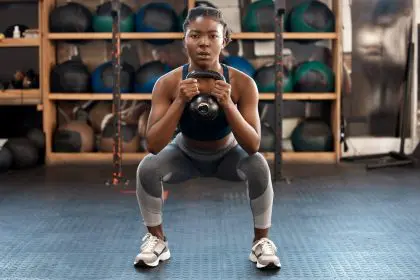That satisfying pull you feel during a deep stretch might not be the beneficial sensation you think it is. While stretching is often portrayed as universally beneficial and risk-free, the reality is more complicated. Many well-intentioned flexibility routines actually create the very problems they aim to prevent.
The line between effective stretching and joint-damaging movements can be surprisingly thin. Whether you’re a dedicated yogi or someone who just tries to touch their toes occasionally, understanding these common stretching mistakes could save your joints from unnecessary wear and tear. Let’s explore the stretching errors that might be sabotaging your body’s long-term mobility.
Bouncing through tight spots
The temptation to bounce when you hit a tight area during stretching is almost instinctual. You reach your limit, feel resistance, and start making little pulsing movements to push beyond it. This approach, technically called ballistic stretching, triggers your body’s protective stretch reflex—the opposite of what you want.
When you bounce, your muscle spindles detect the rapid length change and actually contract the muscle to protect it. This contraction-during-stretching creates opposing forces that concentrate stress on your tendons and joint capsules rather than effectively lengthening the muscle. The sensation of “breaking through” tightness this way often comes from temporarily overriding protective mechanisms, not from actual beneficial change.
The risk increases dramatically at end ranges of motion where your joints are already vulnerable. The quick, forced movements prevent your nervous system from adapting to new ranges, essentially teaching your body to resist rather than accommodate the stretch. Over time, this cycle of resistance and forcing creates exactly the kind of chronic tightness and joint strain you’re trying to solve.
Morning stretching without warming up
Rolling out of bed and immediately dropping into deep stretches seems like a natural way to shake off sleep stiffness. But stretching cold muscles, especially first thing in the morning when your discs are hydrated and more pressurized, creates the perfect environment for tissue damage.
Your muscles and connective tissues are like cold taffy when you first wake up—less elastic and more prone to tearing when suddenly stretched. Morning stiffness isn’t just psychological. Your tissues literally need time to reach optimal temperature for safe stretching. The reduced circulation during sleep leaves your muscles less pliable and your joints more vulnerable.
The spinal discs present a particular morning concern. After horizontal rest, they absorb fluid and expand, making your spine temporarily less flexible and more susceptible to pressure-related injuries. The combination of forward-folding stretches and this morning disc expansion creates significantly higher pressure on the anterior portion of your discs, potentially contributing to bulging or herniation over time.
Pushing through joint-based sensations
Not all stretch sensations are created equal. The feeling of a muscle lengthening differs substantially from the sensation of stress on a joint capsule, yet many people push through both indiscriminately. Learning to distinguish between these feelings represents perhaps the most important stretching skill.
Healthy muscle stretching typically produces a diffuse, broad sensation along the length of the muscle belly itself. Joint stress, by contrast, creates more pinpoint, sharp, or pinching sensations near where bones meet. When you feel these joint-based sensations, your body is warning you that the stretch is compromising structural stability rather than improving muscle length.
The shoulder joint proves especially vulnerable to this confusion. Many people mistake the pinching sensation of the humeral head pressing against the acromion during certain stretches as productive “shoulder opening.” This impingement actually creates the very inflammation and restricted range they’re trying to address. Similar misinterpretations happen at the lumbar spine, knees, and wrists—all joints where mobility should come from proper muscle function, not stretched ligaments.
Holding static stretches before strength activities
The pre-workout static stretching routine remains stubbornly persistent despite substantial evidence against it. Holding stretches for 30+ seconds immediately before activities requiring strength and power temporarily reduces your muscle’s force production capacity and stability—exactly when you need it most.
This temporary strength reduction occurs through several mechanisms. Elongating muscle fibers alters the optimal overlap of actin and myosin, the proteins responsible for muscle contraction. Prolonged stretching also decreases nerve excitability to the muscle, essentially turning down the signal strength that activates your muscle fibers. The result is a muscle temporarily less capable of generating force and stabilizing joints during subsequent activity.
The stability reduction proves even more problematic than the strength decrease. Your proprioceptive system—which tracks your body’s position in space—becomes temporarily less sensitive after static stretching. This reduced position awareness creates a window of vulnerability where your joints receive less accurate feedback about potentially harmful positions. The combination of reduced muscle responsiveness and dampened position sense creates ideal conditions for joint strain.
Stretching around unstable joints
Flexibility without corresponding stability creates vulnerability, particularly for naturally hypermobile people. When a joint already moves beyond its optimal range, stretching the surrounding tissues only exacerbates the problem. Many people mistakenly stretch areas that feel tight without recognizing that the tightness serves a protective function.
This protective tension often develops as your body’s attempt to create stability around a joint that lacks proper muscular control. Your nervous system effectively restricts movement in areas where it detects insufficient stability. Overriding this protective mechanism through aggressive stretching removes a compensatory safeguard without addressing the underlying stability deficit.
The lower back exemplifies this principle perfectly. Lumbar tightness frequently develops in response to core weakness or poor movement patterns. Stretching this area provides temporary relief but can worsen the fundamental stability issue. Without addressing the underlying weakness, the stretching creates additional joint stress by removing the protective tension while leaving the joint inadequately supported.
Focusing on symptom sites rather than cause areas
The area that feels tight is rarely the area that needs stretching. This counterintuitive reality leads countless people to stretch painful or restricted areas, inadvertently reinforcing dysfunctional patterns. Understanding movement relationships between different body segments reveals why this approach often backfires.
Tight hamstrings frequently result from overactive hip flexors and poor pelvic positioning, not intrinsic hamstring shortness. Endlessly stretching the hamstrings without addressing the anterior hip creates a frustrating cycle where the tightness returns immediately. The hamstrings remain protective against the underlying pelvic position issue, which remains unaddressed by the misdirected stretching.
This pattern repeats throughout the body. Tight shoulders often stem from thoracic spine immobility. Calf tightness frequently develops from foot position issues or hip weaknesses. Neck tension commonly originates from upper back restrictions. Chasing the sensation rather than understanding the movement relationships leads to temporary symptom relief while the actual cause continues developing into potentially serious joint problems.
Understanding these common stretching pitfalls doesn’t mean abandoning flexibility work. Rather, it invites a more thoughtful approach that respects your body’s structural needs and protective mechanisms. Small adjustments to your stretching approach can transform potentially harmful movements into genuinely beneficial practices that support joint health for the long term.















